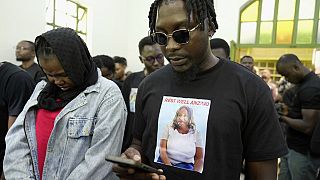Kenya
Much of Kenya's agricultural produce comes from smallholder farmers in rural areas, like this one in Makueni County, Kenyawho.
Many do not have access to adequate cold storage facilities, which means large quantities of produce perish in outside temperatures.
Farmers say this creates an urgency to sell their produce quickly and exposes them to exploitation from unreliable brokers.
But a Kenyan enterprise called SokoFresh that offers rural farmers solar-powered, mobile cold storage facilities has won the backing of rural farmers hoping to reduce post-harvest losses of fresh produce.
Farmers and fresh produce buyers can rent the storage space from SokoFresh for $0.0015 per kilogram of produce.
SokoFresh also buys produce from farmers and connects them directly with large-scale buyers.
"There is a huge difference between SokoFresh and brokers. While using brokers, a lot of produce is lost in the farm because of their delay. SokoFresh harvest on time, pay immediately and store the produce in cold rooms," says farmer Nicholas Wambua.
"Brokers say that they are coming to harvest but they delay, making our oranges spoil. Now we have SokoFresh and they are doing good and pay us on time," says another farmer, Martin Muindi.
According to SokoFresh (a swahili name meaning Market Fresh) about 30%-40% of what rural farmers harvest ends up not getting to the markets because of poor handling and lack of infrastructures in the villages.
"Most of our rural communities, their main economic activity is agriculture. So SokoFresh addresses that issue by being able to provide solar powered cold storage technologies that can be deployed anywhere in remote areas," Denis Karema, founder of SokoFresh.
Kenya is one of the leading countries in Africa when it comes to renewable energy, especially solar power. The country is located near the equator, with an average of five to seven hours of sunlight per day.
Karema says he opted for solar power because it is cost-effective and reliable.
"Bearing in mind that we are in the tropics, solar energy is one of the free sources of energy that could reduce our operational costs. So we opted to use solar, which enables us to deploy anywhere in the country, even in rural areas where electricity is a bit unreliable, solar is always reliable."
About a third of all food produced is lost after harvest, according to the U.N. Food and Agriculture Organization (FAO). These losses include a reduction in the quantity and quality of agricultural produce that occurs at all stages of the supply chain.
Felix Oketch, head of refugee and relief operations at WFP says:
"The major causes of post-harvest loss is how the produce is managed immediately after harvest. Even the harvesting method, sometimes there is damage to the produce itself... Then the biggest one is also around the storage."
SokoFresh was established in 2019 and has served about 12,000 farmers, with 40% being women in rural areas.
The enterprise was set up in partnership with Enviu, EcoZen One Acre Fund, the World Food Programme and financing from the Energy and Environment Partnership Trust Fund (EEP Africa).
It has also extended its services to fish farmers.











00:53
Brazil eyes global food leadership amid U.S.-China trade tensions
Go to video
Oligui Nguema: A breakthrough or continuity for Gabon? [Business Africa]
Go to video
Smart Justice: Kenya’s legal system embraces AI in a rapid digital shift
01:02
First payments made to white farmers affected by land reforms in Zimbabwe
Go to video
A booming market, but lacking data: Africa's challenge [Business Africa]
01:54
Uganda: the infiltration of plastics into agricultural fields and food raise concern